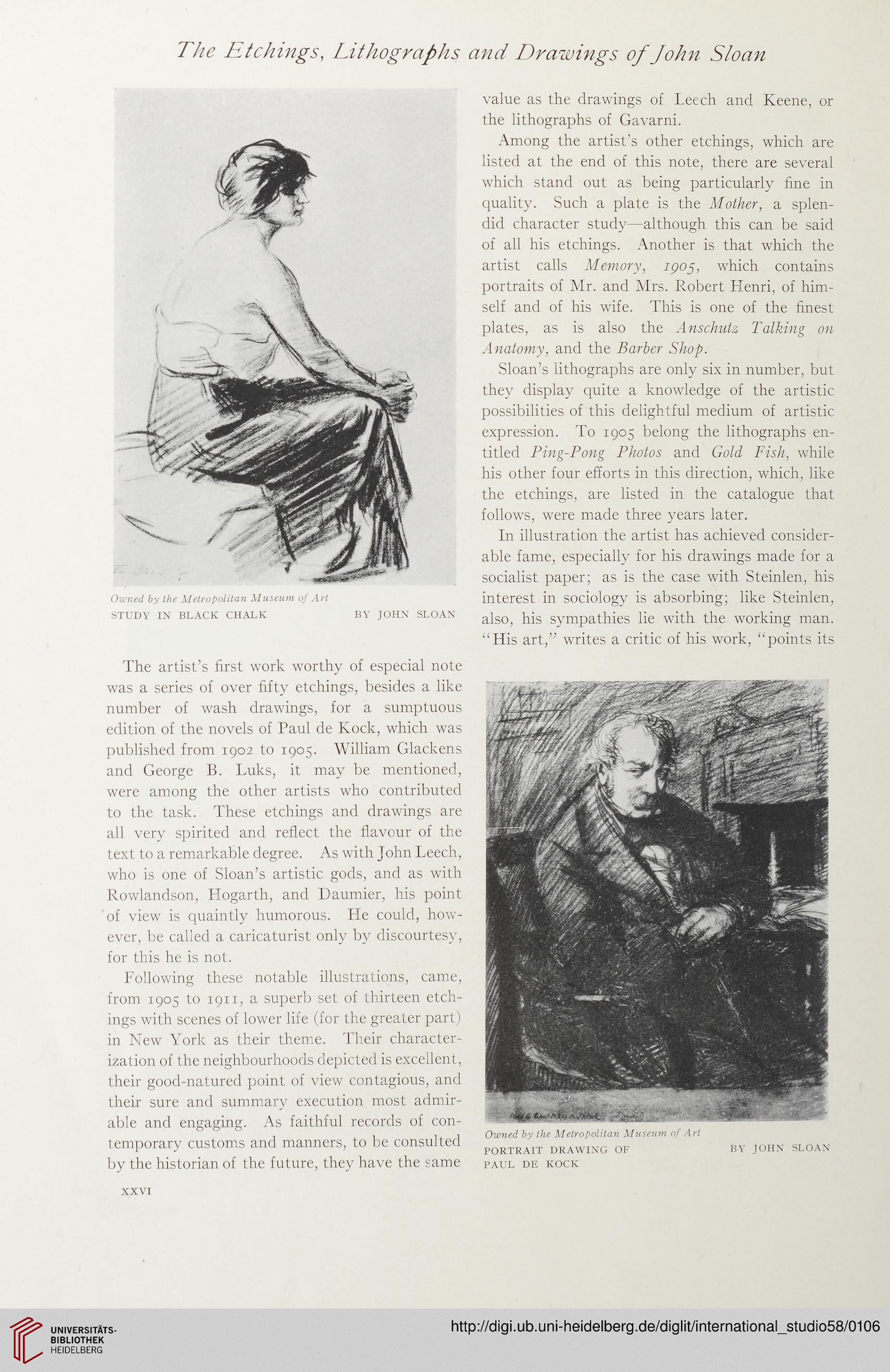The Etchings, Lithographs and Drawings of John Sloan
Owned by the Metropolitan Museum of Art
STUDY IN BLACK CHALK BY JOHN SLOAN
The artist’s first work worthy of especial note
was a series of over fifty etchings, besides a like
number of wash drawings, for a sumptuous
edition of the novels of Paul de Kock, which was
published from 1902 to 1905. William Glackens
and George B. Luks, it may be mentioned,
were among the other artists who contributed
to the task. These etchings and drawings are
all very spirited and reflect the flavour of the
text to a remarkable degree. As with John Leech,
who is one of Sloan’s artistic gods, and as with
Rowlandson, Hogarth, and Daumier, his point
of view is quaintly humorous. He could, how-
ever, be called a caricaturist only by discourtesy,
for this he is not.
Following these notable illustrations, came,
from 1905 to 1911, a superb set of thirteen etch-
ings with scenes of lower life (for the greater part)
in New York as their theme. Their character-
ization of the neighbourhoods depicted is excellent,
their good-natured point of view contagious, and
their sure and summary execution most admir-
able and engaging. As faithful records of con-
temporary customs and manners, to be consulted
by the historian of the future, they have the same
value as the drawings of Leech and Keene, or
the lithographs of Gavarni.
Among the artist’s other etchings, which are
listed at the end of this note, there are several
which stand out as being particularly fine in
quality. Such a plate is the Mother, a splen-
did character study—although this can be said
of all his etchings. Another is that which the
artist calls Memory, 1905, which contains
portraits of Mr. and Mrs. Robert Henri, of him-
self and of his wife. This is one of the finest
plates, as is also the Anschutz Talking on
Anatomy, and the Barber Shop.
Sloan’s lithographs are only six in number, but
they display quite a knowledge of the artistic
possibilities of this delightful medium of artistic
expression. To 1905 belong the lithographs en-
titled Ping-Pong Photos and Gold Fish, while
his other four efforts in this direction, which, like
the etchings, are listed in the catalogue that
follows, were made three years later.
In illustration the artist has achieved consider-
able fame, especially for his drawings made for a
socialist paper; as is the case with Steinlen, his
interest in sociology is absorbing; like Steinlen,
also, his sympathies lie with the working man.
“His art,” writes a critic of his work, “points its
Owned by the Metropolitan Museum of Art
PORTRAIT DRAWING OF BY JOHN SLOAN
PAUL DE KOCK
XXVI
Owned by the Metropolitan Museum of Art
STUDY IN BLACK CHALK BY JOHN SLOAN
The artist’s first work worthy of especial note
was a series of over fifty etchings, besides a like
number of wash drawings, for a sumptuous
edition of the novels of Paul de Kock, which was
published from 1902 to 1905. William Glackens
and George B. Luks, it may be mentioned,
were among the other artists who contributed
to the task. These etchings and drawings are
all very spirited and reflect the flavour of the
text to a remarkable degree. As with John Leech,
who is one of Sloan’s artistic gods, and as with
Rowlandson, Hogarth, and Daumier, his point
of view is quaintly humorous. He could, how-
ever, be called a caricaturist only by discourtesy,
for this he is not.
Following these notable illustrations, came,
from 1905 to 1911, a superb set of thirteen etch-
ings with scenes of lower life (for the greater part)
in New York as their theme. Their character-
ization of the neighbourhoods depicted is excellent,
their good-natured point of view contagious, and
their sure and summary execution most admir-
able and engaging. As faithful records of con-
temporary customs and manners, to be consulted
by the historian of the future, they have the same
value as the drawings of Leech and Keene, or
the lithographs of Gavarni.
Among the artist’s other etchings, which are
listed at the end of this note, there are several
which stand out as being particularly fine in
quality. Such a plate is the Mother, a splen-
did character study—although this can be said
of all his etchings. Another is that which the
artist calls Memory, 1905, which contains
portraits of Mr. and Mrs. Robert Henri, of him-
self and of his wife. This is one of the finest
plates, as is also the Anschutz Talking on
Anatomy, and the Barber Shop.
Sloan’s lithographs are only six in number, but
they display quite a knowledge of the artistic
possibilities of this delightful medium of artistic
expression. To 1905 belong the lithographs en-
titled Ping-Pong Photos and Gold Fish, while
his other four efforts in this direction, which, like
the etchings, are listed in the catalogue that
follows, were made three years later.
In illustration the artist has achieved consider-
able fame, especially for his drawings made for a
socialist paper; as is the case with Steinlen, his
interest in sociology is absorbing; like Steinlen,
also, his sympathies lie with the working man.
“His art,” writes a critic of his work, “points its
Owned by the Metropolitan Museum of Art
PORTRAIT DRAWING OF BY JOHN SLOAN
PAUL DE KOCK
XXVI




